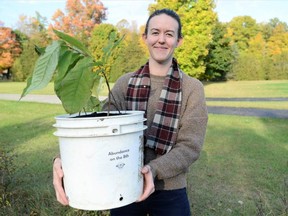
Cross a mango with a banana and you get something close to the pawpaw, a fruit native to Ontario that is making a comeback in Norfolk County and beyond.
Advertisement 2
Article content
With a creamy, custard-like filling and flavor notes of pineapple and coconut, the yellow-fleshed pawpaw resembles tropical fruit like the papaya, which inspired its name. But this hardy fruit tree grows as far north as southern Ontario, where pawpaws once proliferated in the Carolinian forest zone between Windsor and Toronto.
Article content
“It used to be a widespread Indigenous fruit, and because of deforestation across a lot of Ontario, the population has declined,” said Brooke Martin of Abundance on the 8th, an ecotourism business in Norfolk County that, when it opens to the public in the spring, will connect visitors with nature by touring them through the 60-acre Carolinian forest on Martin’s rural property southwest of Simcoe.
Advertisement 3
Article content
Martin’s homestead was one of 20 regional pickup points on the 2023 route for the Pawpaw Parade, an annual effort led by the Carolinian Canada Coalition to restore Ontario’s largest native fruit.
In October, the charity gave away 500 pawpaw saplings and native plant garden kits to home gardeners and community organizations in 23 communities, including 100 trees to First Nations within the Carolinian zone.
To receive a pair of trees, applicants had to tell the organization how they are trying to boost native plants on their properties and in their communities.
The Long Point Basin Land Trust and Meuse Farm Market north of Simcoe also catered to parade participants in Norfolk and Brant counties, while grassroots environmental group Action 13 distributed trees in Hamilton.
Advertisement 4
Article content
“We got lots and lots of applications (and) heard lots of wonderful stories. It was a very difficult selection process,” Samantha Whiteye, Carolinian Canada’s Indigenous leadership director, told The Spectator.
With some care and patience, the saplings will grow to about 15 feet and bear sweet, green-skinned fruit that looks like a mango and is roughly the size of a pear or large avocado.
The vitamin- and mineral-rich fruit from the custard apple family is eaten raw — with its large black seeds removed before the flesh is scooped out — or baked into desserts and mixed into ice cream.
“People used to be able to find them and eat them and enjoy them,” said program specialist Jennifer Nantais.
“Now there are many people who are still awaiting their chance to try the pawpaw fruit for the first time.”
Advertisement 5
Article content
‘Joint effort’ to boost biodiversity
The Pawpaw Parade started in 2019 with a caravan of Carolinian Canada employees delivering saplings sourced from local growers and nurseries to participants across southwestern Ontario.
That first year garnered more than 1,000 inquiries for the roughly 100 trees available. And interest has remained high, with applicants easily outpacing available stock every year.
The pandemic changed the format from having a parade to designating pickup spots along the route, whose hosts await a day of networking in London to collect the trees and trade biodiversity stories.
Martin, in her second year as a pickup site host, appreciates how the pawpaw parade “brings together like-minded people” from across the Carolinian life zone in a “joint effort” to restore a native plant species and boost Ontario’s food sovereignty.
Advertisement 6
Article content
But you won’t find pawpaws in grocery stores or farmers’ markets in Norfolk — at least not yet. The pawpaw’s easily bruised skin and short shelf life — it goes from fully ripe to spoiled in three days, or a bit longer in the fridge — limits its commercial viability.
Norfolk’s relatively tiny pawpaw harvest ends up on the menu at farm-to-table restaurants or shared between growers, native plant enthusiasts and Indigenous groups, meaning you have to be in the know to get your hands on one.
“It’s part of this gift economy,” Martin said.
Seeds of reconciliation
To Martin, restoring the pawpaw is “a form of Indigenous reconciliation,” since the deforestation and habitat loss prompted by colonial settlement led to the fruit’s decline.
Advertisement 7
Article content
The Haudenosaunee brought pawpaw seeds to southern Ontario centuries ago and the trees proliferated, becoming a food source for woodland Indigenous peoples.
“To have these pawpaws, that were a part of our staple diet, go missing, it definitely did impact food security for Indigenous peoples,” Whiteye added.
With forests felled by European settlers looking to farm and build villages, the fruit all but disappeared, surviving today in tiny pockets of old-growth Carolinian forest.
“It’s a consequence of colonialism,” Whiteye said. “As we changed the landscape so much over the last several hundred years, we lost a lot of these species.”
Reintroducing pawpaw trees to the Carolinian landscape provides habitat and food for other native species, which strengthens biodiversity and enhances ecosystems, Nantais noted.
Advertisement 8
Article content
“The pawpaw is really just the ambassador for native plants,” she said. “The real story that we’re trying to tell is planting just one native plant is an act of reconciliation. We’re helping to repair the damage.”
During the parade, Whiteye visits First Nations — including Six Nations and Mississaugas of the Credit — to deliver 10 trees each and educate residents about how to cultivate and use the fruit.
“Getting Indigenous communities to reconnect with this tree and understand the significance of growing it, and have these trees be available to the public so they can start replanting the seeds, I think that’s really important,” Whiteye said.
Whiteye was especially moved to bring pawpaw saplings to her home of Eelūnapéewi Lahkéewiit, in the Chatham-Kent area.
“I feel a sense of accomplishment, because I feel like my ancestors would have wanted this work to happen,” she said.
JP Antonacci is a Local Journalism Initiative Reporter based at the Hamilton Spectator. The initiative is funded by the Government of Canada.
Article content
